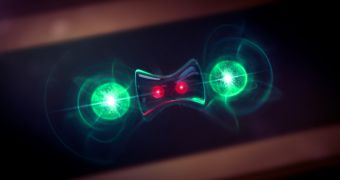A group of physicists with the US National Institute of Standards and Technology (NIST) argues that information loss may actually contribute to improving future computers, and may also bring the development of the first such computer closer than ever.
In a proof-of-concept experiment, the research team was able to entangle two ions through a process that leaked data into the environment. The leak was controlled with extreme accuracy, so the entire effort was successful. The group now plans to see whether or not this approach can be scaled up.
Quantum entanglement is one of the two main processes in quantum mechanics, the other being superposition. When two particles become entangled, their properties become attuned to each other. If the spin of one particle is changed, then the spin of the other changes as well, regardless of distance.
Mastering quantum entanglement is absolutely necessary for the development of quantum bits (qubits) for future computers, the equivalent of regular bits in existing machines. Rather than operating on strings of 1s and 0s, quantum computers will use strings of 1s, 0s, and 1-and-0s.
In the new experiments, the team was able to connect the entangled system to the outside environment, allowing data to leak, while at the same time ensuring that noise and other interferences did not damage the delicate quantum entanglement state. Usually, physicists try their best to isolate entangled atoms.
“These new methods might be used to create entangled states that would be a resource in a traditional, logic-based quantum computer,” explains scientist John Gaebler, a postdoctoral researcher at NIST.
“But there are also alternative architectures in which, for example, one couples a quantum computer to a specific noise environment and the resulting state of the computer contains the solution to the target problem,” the investigator goes on to say.
Details of the new experiments were published in the November 24 online issue of the top scientific journal Nature. The work was carried by NIST scientists, in collaboration with Danish researchers from the University of Copenhagen.

 14 DAY TRIAL //
14 DAY TRIAL //